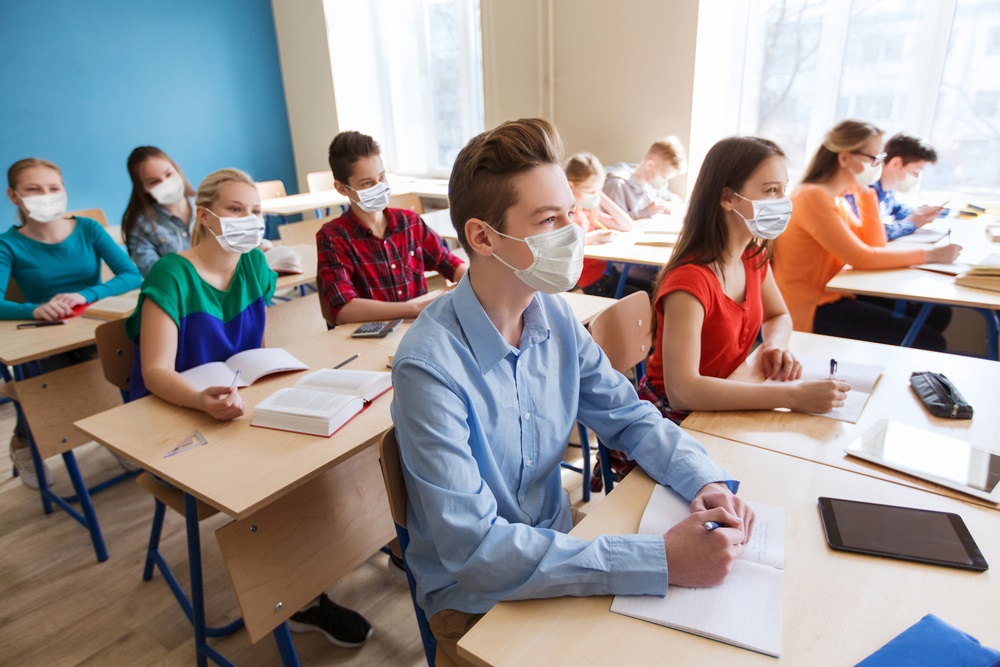Depression, anxiety, and suicide rates rise as a result of COVID response
COVID is killing people, including our kids. When I say that, I am not talking about children, teens, and adults just dying from the virus. I am referring to the suicides that are a direct result of the public health response to the virus. We are experiencing not just a global coronavirus pandemic, but a public health suicide crisis.
The Centers for Disease Control (CDC) issued the results of a survey it conducted on August 14, 2020, “Mental Health, Substance Use, and Suicidal Ideation During the COVID-19 Pandemic” in which the United States’ leading public health organization unveiled the backlash of lockdowns, school closures, and social isolation. Between June 24 and June 30, 2020, U.S. adults reported considerably elevated adverse mental health conditions associated with COVID-19, according to the report. It also reported, “Younger adults, racial/ethnic minorities, essential workers, and unpaid adult caregivers reported having experience disproportionately worse mental health outcomes, increased substance use, and elevated suicidal ideation.”
Furthermore, the report shows that the symptoms of anxiety disorder and depressive disorder “increased considerably in the United States” between April and June 2020 when compared with the same period in 2019. Factors such as social isolation, absence of school structure, unemployment and other financial worries, and various forms of violence contributed to these adverse mental health conditions.
A Sept. 18, 2020, blog by Edward-Elmhurst Health reported that teens are particularly susceptible to the risk of suicide during the pandemic. Between “missing friends, or more serious stressors like a parent losing a job, someone getting sick, or an unstable home life” rates of teen depression, anxiety, and suicidal ideation are on the rise among young people.
In Arizona, as in the rest of the nation, there has been a dramatic increase in the number of suicides among teens. According to America’s Health Rankings, teen suicide has been on the rise since 2016 and there has been a jump in 2020 alone with 14.1 suicides per 100,000 persons in Arizona alone.
“Suicide is a serious public health problem among all age groups,” according to America’s Health Rankings. “Among youth it exacts an enormous toll due to the significant years of potential life lost. In 2017, there were more than 6,200 suicide deaths among adolescents and young adults ages 15-24, making it the second-leading cause of death for that age group.”
The Arizona Department of Health Services has a data dashboard that is frequently updated. Since the first reported case of COVID in Arizona in January 2020, there have been 11 deaths in Arizona of persons age 20 and under. In the same period, 43 children committed suicide in Arizona with nearly 30 percent of those occurring in Pima County alone, according to a Nov. 10, 2020, report by KGUN 9 about teen suicides. That report showed a marked increase in teen suicides in Arizona in 2020. That is a jump from the 2019 Arizona teen suicide total of 38 and the year isn’t over yet.
According to the Arizona Department of Health Services 2019 State of Health Assessment, “Suicide is the second leading cause of death among adults ages 20 to 44. Arizona experiences higher rates of suicide mortality (18.0 per 100,000) than the country as a whole (14.0 per 100,000), but the rate of growth from 2013 to 2017 is roughly half the national growth rate.” The same assessment showed there were five suicides for every 100,000 people aged 10 to 14 in 2017 and 20 per 100,000 in the 15-19 age group in the same year.
In a Sept. 10, 2020, article by AZCentral, it was reported that, “Suicide is the leading cause of death for Arizonans ages 10-14 and nearly 1,500 Arizonans took their own lives in 2019 – one suicide approximately every six hours.” The same article stated information in The Journal of the American Medical Association (JAMA), a leading medical journal, and the CDC suggest there exists secondary consequences of social distancing policies that may be increasing the risk of suicide.
“Officials are particularly concerned the isolation and anxiety prompted by the pandemic has exacerbated mental health issues among those Arizonans most vulnerable to suicide, including veterans, older adults, people living in rural areas, and young people,” reported AZCentral.
“This is a top priority, but we cannot do it alone,” said Arizona Governor Doug Ducey regarding the increases in suicide. “We need everyone in the community – parents, teachers, children, coaches, friends, coworkers, and more – to know the signs of someone struggling with mental health and how to act.” With closures of schools and the halting of youth sports, teachers, coaches, friends, and teammates have less exposure to those that are at a higher risk. This is even truer for children and teens left at home alone day after day as parents report to work outside of the home.
An April 10, 2020, article in by JAMA reported, “Remarkable social distancing interventions have been implemented to fundamentally reduce human contact. While these steps are expected to reduce the rate of new (COVID) infections, the potential for adverse outcomes on suicide risk is high.”
The CDC shows the latest suicide statistics from 2018 nationwide at 48,344 with 1,438 of those occurring in Arizona. According to the Pima County Health Department in a piece by Arizona Public Media, there were 22 deaths by suicide between March 1 and March 28, 2020, compared to just 12 in February 2020. A health alert was issued by the Pima County Health Department on May 1, 2020, regarding a spike in the number of confirmed suicides in Pima County while another health alert was issued just 13 days later regarding a sustained increase in Fentanyl-related overdose deaths. The Pima County Health Department issued another alert July 15, 2020, regarding a sustained increase in Fentanyl-related overdose deaths in young people. Yet another health alert was issued Nov. 4, 2020, regarding a record number of drug overdose deaths in 2020 by the Pima County Health Department as well. A pattern of increased suicide and drug overdoses is occurring and yet the Pima County Health Department ignores this threat while increasing recommendations for lockdowns and school closures due to COVID-19 which has a 97 to 99.75 percent recovery rate.
Another article by faculty experts at the Johns Hopkins Center for Adolescent Health, “The Impact of the COVID-19 Pandemic on Adolescents,” stated there are two distinct developmental tasks teens experience during these formative years: to develop social skills and empathy and a sense of identity.
“Both of these tasks happen through interactions with peers,” said Beth Marshall, associate director of the Johns Hopkins Center for Adolescent Health and an assistant scientist at the Bloomberg School of Public Health in the article. “Disconnection from social outlets and peers will have some implications when we return to social settings. Schools are much more than just a place for delivering educational content, and I think that schools have started to recognize that students will come back with not only educational setbacks but also setbacks to their social emotional skills.”
Tamar Medelson, director of the John Hopkins Center for Adolescent Health and Bloomberg Professor of American Health at the Bloomberg School of Public Health, said in the same piece, “The greatest impacts felt by adolescents stem from school closures, being in the house with family members, and not getting to see friends and peers. Adolescents have different developmental needs than adults. Teenagers are at the stage in life when they are very interested in social connections and in separating from their parents. So, COVID-19 social distancing requirements have a different emotional impact on them than on adults.”
Regular physical activity is also critical during the pandemic in the battle against depression, anxiety, and suicidal ideation. According to the World Health Organization (WHO), “Being physically active is good for your health, both physical and mental. Set up a regular routine to practice activities or sports that do not require close contact with others every day for one hour.”
The CDC webpage, “Consideration for Youth Sports,” states, “Each community may need to make adjustments to meet its unique needs and circumstances. Implementation should be guided by what is practical, acceptable, and tailored to the needs of each community. There are a number of actions youth sports organizations can take to help lower the risk of COVID-19 exposure and reduce the spread during competition and practice.”
“Parks, trails, and open spaces can provide opportunities for physical activity while also providing opportunities for a break, health, and wellness,” according to the CDC webpage “Guidance for Administrators in Parks and Recreational Facilities.”
The CDC also discusses “Health Equity” as everyone having the opportunity to “be as healthy as possible.” When it comes to being able to afford a gym membership, many families and individuals cannot afford that cost and participating in outdoor activities is often free or less expensive. Additionally, the CDC explains that outdoor spread is less likely than indoor spread with the natural ventilation of the great outdoors. Most gyms operate in enclosed spaces indoors so seeking exercise outdoors where people have more room to social distance is safer.
It’s time to allow our children, our future, to return to school so they can get the education they deserve, socialize with their friends and peers, and experience life as they should. Allowing children and youth to return to sports where the positive health implications far outweigh the risk of contracting the coronavirus is also necessary. We have a serious issue with obesity, heart disease, and type-2 diabetes in the United States. Physical activity helps to reduce those problems while simultaneously improving the mental and emotional health of those who participate.
Another thing to consider is that people are suffering as a result of lock down and stay-at-home orders. People living in nursing homes and assisted living facilities are more isolated now than ever before as visitors are reduced or not allowed at all. We are allowing the sick and dying to suffer alone in hospitals across the country as families are not allowed in to see them. If we are not living, are not with the ones we love, and can’t do the things that make us happy, what are we trying to stay alive for? If our public health policies and response the pandemic lead us down the path of losing our humanity, are they really effective?
Finally, ignoring the issues of suicide, depression, anxiety, social isolation, and the closure of schools and sports could have substantial negative implications for the future of our great nation. The children who are kept out of school and isolated today will be leading our nation in 10 to 20 years. How will they be able to lead with a subpar education, hampered social skills, and increased mental health issues?
Ultimately, public health officials and politicians charged with responding to COVID-19 need to consider the expansive, long-term consequences of their decisions. They need to weigh the positive results of their policies and mandates with the unintended consequences that are leading people to kill themselves. This is especially true for our youth who are at lowest risk for contracting the virus, spreading it, and sustaining long-term consequences including death.
Despite our political leanings, it’s time for all of us to embrace the wise words of President Franklin D. Roosevelt: “There is nothing to fear but fear itself.” While we continue to wear our masks, wash our hands, stay home when we are sick, and avoid large gatherings, it’s time that we all get back to living. If we don’t, it could cost us our lives.


